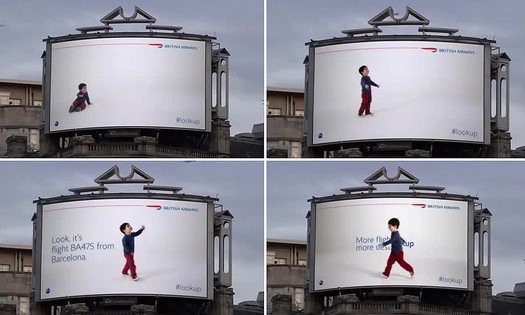Editor's Note: Gideon Amichay is an advertising executive, marketer and author. He is the founder and chief creative officer of NO, NO, NO, NO, NO, YES, a creative boutique in New York. He also teaches at the School of Visual Arts in New York city. The winner of 19 Cannes Lions for his advertising campaigns, Amichay is currently in Cannes and has been sending in regular award dispatches.
Two projects that symbolize the growing hybrid of old media with new media technologies won multiple gold lions at Cannes this week. Each one shows that traditional advertising and old media are not dead: they just need to evolve to stay relevant in a more complex media environment.
The first example is a billboard called The Magic of Flying. Created by Ogilvy One London for British Airways, it's a digital billboard that uses surveillance technology to display a child pointing at any British Airways plane flying overhead, along with the flight number and the departure city. (You can see it here.)
The second is a poster called The Social Swipe which was created by Kolle Rebbe, Hamburg, for the non-profit company MISEREOR. It's a dual screen interactive “poster” with a credit card swipe in the middle that allows passersby to donate a small amount to charity and, in so doing, help fight third world poverty. (You can see it in action above.)
Before the birth of the technologies that made such things actionable it would have been impossible to even imagine such things — to even consider being this creative with a billboard or a poster — because they simply couldn’t be produced. Experimentation in either venue was restricted to what was, in fact, achievable. Today these kinds of projects inspire everyone to be more creative and to push boundaries: a billboard or a poster can become a magnet for the public’s attention. It can even — as in the case of The Social Swipe poster — suggest new model for transactions, a business solution. It’s a win-win for everyone.

The Magic of Flying interactive billboards
As advertising solutions, both of these examples represent a big step towards reaching real people: they’re more entertaining, more enjoyable and becuse they're so much more intreactive, they're more memorable. Most critical, perhaps, is the actual role the would-be consumer plays: by engaging real people in tangible activities, a person can actively share a moment instead of bypassing it. At a cultural moment in which advertising is struggling to retain its power, The Social Swipe and The Magic of Flying demonstrate the degree to which it is possible to reach people in a more intellectually satisfying and emotionally dynamic way.
Technology, too, shows us that any poster or billboard can become a success. In a sense, it is really just another powerful screen. Creative uses of technology in favor of brands can connect with people better and engage with them more effectively on the spot. (This was the classic — if somewhat dated — contribution made by outdoor advertising.) Technology adds a new edge by bringing another level of interaction. By reaching one person at one moment, advertising leads to a new and intriguing kind of empowerment.
In the end, companies and their respective brands should begin to rethink new roles for old media: classic advertising models are not dead. They're simply waiting for new ideas.
The Social Swipe and The Magic of Flying are showing the way.
